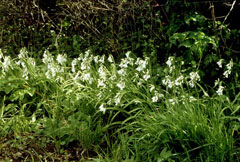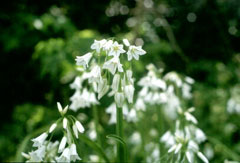 |
|
(c) 2010 Ken Fern, Plants For A Future |
 |
| (c) 2010 Ken Fern, Plants For A Future |
Translate this page:
Summary
Physical Characteristics

 Allium triquetrum is a BULB growing to 0.4 m (1ft 4in).
Allium triquetrum is a BULB growing to 0.4 m (1ft 4in).
See above for USDA hardiness. It is hardy to UK zone 8 and is not frost tender. It is in leaf from February to July, in flower from April to June. The species is hermaphrodite (has both male and female organs) and is pollinated by Bees, insects.
Suitable for: light (sandy) and medium (loamy) soils and prefers well-drained soil. Suitable pH: mildly acid, neutral and basic (mildly alkaline) soils. It can grow in full shade (deep woodland) semi-shade (light woodland) or no shade. It prefers moist soil.
UK Hardiness Map
US Hardiness Map
Synonyms
Plant Habitats
Woodland Garden Dappled Shade; Shady Edge; not Deep Shade; Hedgerow;
Edible Uses
Edible Parts: Flowers Leaves Root
Edible Uses:
Bulb - raw or cooked. The rather small bulb is up to 20mm in diameter[200], it has a mild garlic flavour and can be used as a flavouring in salads and cooked foods. It is harvested in early summer when the plant has died down and will store for at least 6 months[K]. Leaves - raw or cooked. A leek substitute[22]. The leaves are available from late autumn until the spring, they are nice in salads when they are young, or cooked as a vegetable or flavouring as they get older[K]. The leaves have a milder and more delicate flavour than onions[183]. Flowers - raw. Juicy with a mild garlic flavour, they make a tasty and decorative garnish on salads[K].
References More on Edible Uses
Medicinal Uses
Plants For A Future can not take any responsibility for any adverse effects from the use of plants. Always seek advice from a professional before using a plant medicinally.
Although no specific mention of medicinal uses has been seen for this species, members of this genus are in general very healthy additions to the diet. They contain sulphur compounds (which give them their onion flavour) and when added to the diet on a regular basis they help reduce blood cholesterol levels, act as a tonic to the digestive system and also tonify the circulatory system[K].
References More on Medicinal Uses
The Bookshop: Edible Plant Books
Our Latest books on Perennial Plants For Food Forests and Permaculture Gardens in paperback or digital formats.

Edible Tropical Plants
Food Forest Plants for Hotter Conditions: 250+ Plants For Tropical Food Forests & Permaculture Gardens.
More

Edible Temperate Plants
Plants for Your Food Forest: 500 Plants for Temperate Food Forests & Permaculture Gardens.
More

More Books
PFAF have eight books available in paperback and digital formats. Browse the shop for more information.
Shop Now
Other Uses
Repellent
The juice of the plant is used as a moth repellent. The whole plant is said to repel insects and moles[20].
Special Uses
Scented Plants
References More on Other Uses
Cultivation details
Prefers a rich moist but well-drained soil[1, 42]. Shade tolerant[31], it is easily grown in a cool leafy soil[90] and grows well in light moist woodland[203]. Plants are not very hardy outside the milder areas of Britain, they tolerate temperatures down to between -5 and -10°c. The bulbs should be planted fairly deeply[1]. The seeds have an oil-bearing appendage which is attractive to ants. The ants carry the seed away to eat the oil and then discard the seed, thus aiding dispersal of the plant[203]. Grows well with most plants, especially roses, carrots, beet and chamomile, but it inhibits the growth of legumes[18, 20, 54]. This plant is a bad companion for alfalfa, each species negatively affecting the other[201]. The flowers are sweetly scented[245]. The picked flowers can remain fresh for several weeks[89]. Members of this genus are rarely if ever troubled by browsing deer[233].
References Carbon Farming Information and Carbon Sequestration Information
Temperature Converter
Type a value in the Celsius field to convert the value to Fahrenheit:
Fahrenheit:
The PFAF Bookshop
Plants For A Future have a number of books available in paperback and digital form. Book titles include Edible Plants, Edible Perennials, Edible Trees,Edible Shrubs, Woodland Gardening, and Temperate Food Forest Plants. Our new book is Food Forest Plants For Hotter Conditions (Tropical and Sub-Tropical).
Shop Now
Plant Propagation
Seed - best sown as soon as it is ripe in a greenhouse or cold frame. It germinates quickly and can be grown on in the greenhouse for the first year, planting out the dormant bulbs in the late summer of the following year if they have developed sufficiently, otherwise grow on in pots for a further year. Stored seed can be sown in spring in a greenhouse. Division in summer after the plants have died down. Very easy, the divisions can be planted straight out into their permanent positions.
Other Names
If available other names are mentioned here
Native Range
EUROPE: Italy (incl. Sardinia, Sicily), Spain (incl. Baleares), France (incl. Corsica) AFRICA: Algeria, Morocco, Tunisia
Weed Potential
Right plant wrong place. We are currently updating this section.
Please note that a plant may be invasive in one area but may not in your area so it's worth checking.
Conservation Status
IUCN Red List of Threatened Plants Status :

| Related Plants
|
| Latin Name | Common Name | Habit | Height | Hardiness | Growth | Soil | Shade | Moisture | Edible | Medicinal | Other |
| Allium acuminatum | Hooker's Onion, Tapertip onion | Bulb | 0.3 |
5-9
| | LM | N | DM | 3 | 2 | 2 |
| Allium aflatunense | Persian Onion, Ornamental Onion | Bulb | 1.0 |
4-8
| M | LM | N | M | 2 | 2 | 1 |
| Allium akaka | | Bulb | 0.2 |
7-10
| | LM | N | DM | 3 | 2 | 1 |
| Allium altaicum | | Bulb | 0.3 |
-
| | LM | N | M | 3 | 2 | 1 |
| Allium ampeloprasum | Wild Leek, Broadleaf wild leek | Bulb | 1.8 |
5-9
| | LMH | N | DM | 5 | 3 | 2 |
| Allium ampeloprasum babingtonii | Babington's Leek | Bulb | 1.8 |
0-0
| | LMH | N | DM | 3 | 3 | 2 |
| Allium angulare | | Bulb | 0.0 |
-
| | LM | N | M | 3 | 2 | 1 |
| Allium angulosum | Mouse Garlic | Bulb | 0.5 |
4-8
| | LMH | SN | M | 3 | 2 | 1 |
| Allium atropurpureum | | Bulb | 1.0 |
7-10
| | LM | SN | M | 3 | 2 | 1 |
| Allium bisceptrum | Aspen Onion, Twincrest onion | Bulb | 0.3 |
7-10
| | LM | N | M | 3 | 2 | 1 |
| Allium bodeanum | | Bulb | 0.2 |
-
| | LM | N | DM | 3 | 2 | 1 |
| Allium bolanderi | Bolander's Onion | Bulb | 0.2 |
6-9
| | LM | N | M | 3 | 2 | 1 |
| Allium brevistylum | Shortstyle Onion | Bulb | 0.5 |
-
| | LM | N | MWe | 3 | 2 | 1 |
| Allium canadense | Canadian Garlic, Meadow garlic, Fraser meadow garlic, Hyacinth meadow garlic | Bulb | 0.5 |
4-8
| | LM | SN | MWe | 4 | 2 | 2 |
| Allium canadense mobilense | Canadian Garlic | Bulb | 0.5 |
4-8
| | LM | SN | MWe | 5 | 2 | 1 |
| Allium carinatum | Keeled Garlic | Bulb | 0.6 |
6-9
| | LMH | SN | M | 3 | 2 | 1 |
| Allium carolinianum | | Bulb | 0.4 |
-
| | LM | N | DM | 3 | 2 | 1 |
| Allium cepa | Onion, Garden onion | Bulb | 0.6 |
4-10
| M | LM | N | M | 5 | 3 | 3 |
| Allium cepa aggregatum | Potato Onion | Bulb | 1.2 |
4-8
| M | LM | N | M | 4 | 3 | 3 |
| Allium cepa ascalonicum | Shallot | Bulb | 0.3 |
4-8
| | LM | N | M | 5 | 3 | 2 |
| Allium cepa proliferum | Tree Onion, Walking Onion | Bulb | 1.2 |
4-8
| M | LM | N | M | 5 | 3 | 3 |
| Allium cernuum | Nodding Onion, New Mexican nodding onion | Bulb | 0.5 |
5-9
| F | LMH | N | M | 5 | 2 | 2 |
| Allium chinense | Rakkyo | Bulb | 0.3 |
6-9
| | LM | N | M | 4 | 2 | 1 |
| Allium condensatum | | Bulb | 0.6 |
4-8
| | LM | N | M | 3 | 2 | 1 |
| Allium cupanii | | Bulb | 0.3 |
7-10
| | LM | N | DM | 3 | 2 | 1 |
| Allium douglasii | Douglas' Onion | Bulb | 0.3 |
0-0
| | LM | N | DM | 3 | 2 | 1 |
| Allium dregeanum | Wild Onion | Bulb | 0.6 |
-
| | LM | N | DM | 3 | 2 | 1 |
| Allium drummondii | Prairie Onion, Drummond's onion | Bulb | 0.3 |
6-9
| | LM | N | M | 3 | 2 | 1 |
| Allium fistulosum | Welsh Onion | Bulb | 0.6 |
5-9
| F | LMH | N | M | 5 | 2 | 2 |
| Allium flavum | Small Yellow Onion, Ornamental Onion | Bulb | 0.5 |
4-7
| M | LMH | SN | M | 2 | 2 | 1 |
|
|
Growth: S = slow M = medium F = fast. Soil: L = light (sandy) M = medium H = heavy (clay). pH: A = acid N = neutral B = basic (alkaline). Shade: F = full shade S = semi-shade N = no shade. Moisture: D = dry M = Moist We = wet Wa = water.
Now available:
Food Forest Plants for Mediterranean Conditions
350+ Perennial Plants For Mediterranean and Drier Food Forests and Permaculture Gardens.
[Paperback and eBook]
This is the third in Plants For A Future's series of plant guides for food forests tailored to
specific climate zones. Following volumes on temperate and tropical ecosystems, this book focuses
on species suited to Mediterranean conditions—regions with hot, dry summers and cool, wet winters,
often facing the added challenge of climate change.
Read More
Expert comment
Author
L.
Botanical References
200
Links / References
For a list of references used on this page please go here
Readers comment